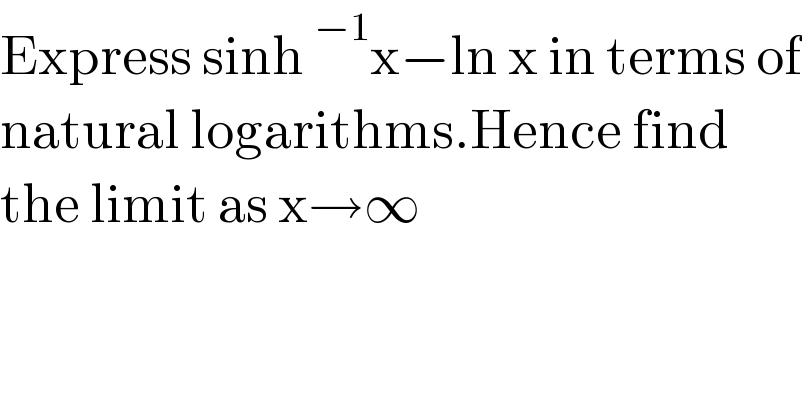
Question Number 178412 by Spillover last updated on 16/Oct/22

$$\mathrm{Express}\:\mathrm{sinh}\:^{−\mathrm{1}} \mathrm{x}−\mathrm{ln}\:\mathrm{x}\:\mathrm{in}\:\mathrm{terms}\:\mathrm{of} \\ $$$$\mathrm{natural}\:\mathrm{logarithms}.\mathrm{Hence}\:\mathrm{find} \\ $$$$\mathrm{the}\:\mathrm{limit}\:\mathrm{as}\:\mathrm{x}\rightarrow\infty \\ $$
Answered by Ar Brandon last updated on 16/Oct/22

$$\mathrm{sinh}^{−\mathrm{1}} {x}−\mathrm{ln}{x}=\mathrm{ln}\left({x}+\sqrt{\mathrm{1}+{x}^{\mathrm{2}} }\right)−\mathrm{ln}{x} \\ $$$$\underset{{x}\rightarrow\infty} {\mathrm{lim}}=\underset{{x}\rightarrow\infty} {\mathrm{lim}ln}\left(\frac{{x}+\sqrt{\mathrm{1}+{x}^{\mathrm{2}} }}{{x}}\right) \\ $$$$=\underset{{x}\rightarrow\infty} {\mathrm{lim}ln}\left(\mathrm{1}+\sqrt{\frac{\mathrm{1}}{{x}^{\mathrm{2}} }+\mathrm{1}}\right)=\mathrm{ln2} \\ $$
Commented by Spillover last updated on 16/Oct/22

$${thanks} \\ $$
